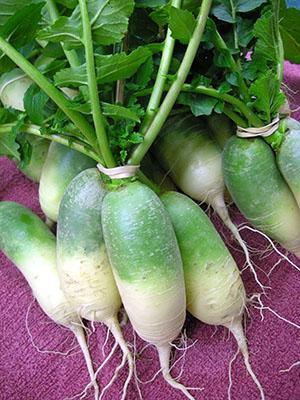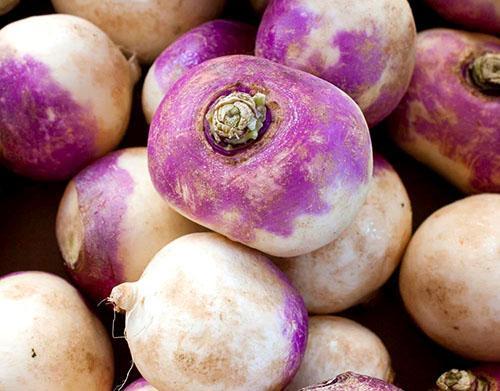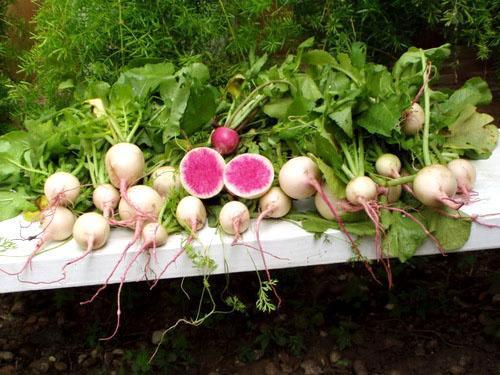Margelan radish, Chinese radish or lobo
 The Margelan radish received such an unusual name in honor of the ancient capital of the Silk Road, which ran from China, through the countries of Central and Asia Minor to Europe. The root crop that got to the city of Margilan fell in love with the inhabitants of the Fergana Valley, began to be cultivated by local peasants and, together with the production of silk, became part of the local culture and history.
The Margelan radish received such an unusual name in honor of the ancient capital of the Silk Road, which ran from China, through the countries of Central and Asia Minor to Europe. The root crop that got to the city of Margilan fell in love with the inhabitants of the Fergana Valley, began to be cultivated by local peasants and, together with the production of silk, became part of the local culture and history.
However, the Margelan radish has other names as well. Many people know this culture as Chinese or green radish, and the inhabitants of the Middle Kingdom themselves call the vegetable lobo. Moreover, the existing Chinese version of the tale about the turnip tells about the ordeal of a peasant who has grown a Margelan radish and without success pulls it out of the ground.
The lobo root vegetable, which contains a trace amount of mustard oil, is softer than the flesh of European radishes and other varieties of sowing radish.

By the way, radish varieties with a greenish surface layer and bright purple or reddish pulp are called watermelon. And today such a Margelan radish is grown by gardeners all over the world and is at the peak of popularity among gourmets.
 Chinese or Margelan radish is larger than black radish and radish... The average weight of a root crop can vary from 300 to 1500 grams. And, despite the fact that the Chinese guest in the Russian gardens is not too capricious, it is quite reasonable for such a culture to need care and sufficient attention.
Chinese or Margelan radish is larger than black radish and radish... The average weight of a root crop can vary from 300 to 1500 grams. And, despite the fact that the Chinese guest in the Russian gardens is not too capricious, it is quite reasonable for such a culture to need care and sufficient attention.
Planting and caring for Margelan radish
 Like other types of root crops, lobo is sown directly into the ground. The time when you can plant Margelan radish is chosen depending on the early maturity of the selected variety and the climatic features of the region. Most often, seeds enter the soil at one of two time intervals:
Like other types of root crops, lobo is sown directly into the ground. The time when you can plant Margelan radish is chosen depending on the early maturity of the selected variety and the climatic features of the region. Most often, seeds enter the soil at one of two time intervals:
- Spring sowing is carried out from the second half of April to mid-May.
- In summer, Margelan radish can be planted from the first decade of July until September, if the weather permits.
 If you sow the lobo in the spring, you can face the massive formation of peduncles on plants that have not yet formed a root crop. This is due to the increasing daylight hours at this time and the hot beginning of summer.
If you sow the lobo in the spring, you can face the massive formation of peduncles on plants that have not yet formed a root crop. This is due to the increasing daylight hours at this time and the hot beginning of summer.
Bloomed plants will have to be removed, since they cannot be used for food, and the garden must be sown.
Sowing and growing Margelan radish in the second period excludes such an unpleasant possibility, and since the plant tolerates light frosts quite easily, the roots have time to gain weight and juiciness before the onset of stable cold weather.
The best temperature for plant development is 18-22 ° C, while the seeds start growing already at 4-5 ° C. But in hot weather, when the average daily temperature exceeds +25 ° C, as well as in spring, when the air does not warm up more than +15 ° C, the risk of seeing flower stalks above the bed grows seriously.
Choosing a site for growing Margelan radish
 Margelan radish yields good yields on neutral or slightly acidic soils, mainly light, rich in organic matter.
Margelan radish yields good yields on neutral or slightly acidic soils, mainly light, rich in organic matter.
The soil for sowing the culture is prepared in advance, compost, mullein or compost is applied not under the radish itself, but under the previous plant.
This is due to the fact that root crops, in the presence of fresh manure in the soil, can accumulate nitrogen, lose their taste and marketability, crack and be stored worse.
If a organic fertilizers not introduced on time, it is better to do only with mineral supplements. When digging, for each square meter of soil, 20-30 grams of potassium fertilizers, superphosphate and ammonium sulfate are applied. It is necessary to dig a plot for Chinese radish deeply, not less than 25-30 cm. If sowing is to be carried out in a lowland, it is better to raise the beds by 10-15 cm.
 The future harvest depends on the quality of the seeds. When it comes time to plant Margelan radish, before sowing, the seed is sorted out, separating empty, damaged or unripe seeds. Since the Chinese radish is distinguished by large roots, the grooves are made at a distance of at least 30 cm. Seeds are sown in two or three pieces at a distance of 15-18 cm from each other.
The future harvest depends on the quality of the seeds. When it comes time to plant Margelan radish, before sowing, the seed is sorted out, separating empty, damaged or unripe seeds. Since the Chinese radish is distinguished by large roots, the grooves are made at a distance of at least 30 cm. Seeds are sown in two or three pieces at a distance of 15-18 cm from each other.
- Before sowing, the beds are watered, and after the soil is sealed, if necessary, watering the Margelan radish is carefully repeated.
- Seedlings will appear much faster if covering material is spread on the site, which can be removed when the shoots hatch.
- If soaked seeds were used, the emergence of shoots should be expected in a week, dry seeds germinate a few days longer.
 At the stage of two or three leaves, plantings are thinned out.
At the stage of two or three leaves, plantings are thinned out.
Transplanting seedlings is not recommended, but if it is necessary to do this, it is important not to damage the root and transfer the plant only with a lump of earth.
Margelan radish care and growing problems
 As it grows, Margelan radish requires abundant, frequent watering, especially during the period of root crop growth. The culture that remains without moisture in hot weather grows worse, loses its juiciness, and its taste deteriorates sharply.
As it grows, Margelan radish requires abundant, frequent watering, especially during the period of root crop growth. The culture that remains without moisture in hot weather grows worse, loses its juiciness, and its taste deteriorates sharply.
- When root crops grow to the size of a 10-ruble coin, they are fed for the first time, applying 25-30 grams of complex fertilizer per square meter.
- On sandy or other, not very nutritious soils, feeding is repeated twice, and on rich soils only once.
- Three weeks before the moment when it is necessary to harvest the crop, the application of especially nitrogen fertilizers is stopped.
 Apart from watering and feeding, caring for the planted Margelan radish is not complete without other measures. Under the foliage rosettes, all weeds, as well as all yellowed leaves that have sunk to the ground, must be removed, which will allow the light to better penetrate deep into the plantings and prevent pests and pathogens from appearing on the radish. For the same purpose, as well as to reduce the risk of developing flowering, healthy leaves are cut off, blocking the access of air and light to the plants in the garden.
Apart from watering and feeding, caring for the planted Margelan radish is not complete without other measures. Under the foliage rosettes, all weeds, as well as all yellowed leaves that have sunk to the ground, must be removed, which will allow the light to better penetrate deep into the plantings and prevent pests and pathogens from appearing on the radish. For the same purpose, as well as to reduce the risk of developing flowering, healthy leaves are cut off, blocking the access of air and light to the plants in the garden.
The tops of the root crops that appear above the soil level are neatly huddled, preventing the radish from hardening in the air and being attacked by slugs and other pests.
Among the enemies of the Chinese radish are insects that parasitize plants of the cabbage family. Therefore, it is better not to grow Margelan radish after radish, all types of cabbage, mustard or turnip, and preventively, the beds are treated with tobacco dust or wormwood infusion.
When to dig up a radish?
 Although Margelan radish tolerates slight frosts, it is better to harvest the roots before the onset of cold weather. When to dig up a lobo radish? In this case, you can focus on the timing of the ripening of the culture:
Although Margelan radish tolerates slight frosts, it is better to harvest the roots before the onset of cold weather. When to dig up a lobo radish? In this case, you can focus on the timing of the ripening of the culture:
- Early varieties are ready for digging 57–70 days after germination.
- Mid-season and late Chinese radish is harvested after 70-110 days.
Cleaning is done in dry weather. If you have to harvest a summer harvest, it is better to pull out the radish in the morning or in the evening, when there is no bright sun.
 On loose, light soil, you can pull out the Margelan radish by grasping the tops, not far from the base of the outlet. And in order not to damage the large radish on chernozems or clay soil, you will have to carefully dig in the roots.
On loose, light soil, you can pull out the Margelan radish by grasping the tops, not far from the base of the outlet. And in order not to damage the large radish on chernozems or clay soil, you will have to carefully dig in the roots.
Healthy root crops without cuts and scratches are stored, the tops of which are removed, leaving the stalks no longer than 2-3 cm. In a cellar or basement, Margelan radish can be stored until spring. To do this, the roots are placed in boxes and sprinkled with sand, after which the containers are placed in a room with a temperature of 0–1 ° C and an air humidity of about 85–90%.